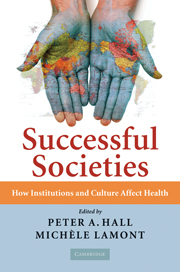Book contents
- Frontmatter
- Contents
- Contributors
- Preface
- Introduction
- 1 Population Health and the Dynamics of Collective Development
- 2 Social Interactions in Human Development: Pathways to Health and Capabilities
- 3 Health, Social Relations, and Public Policy
- 4 Population Health and Development: An Institutional-Cultural Approach to Capability Expansion
- 5 Responding to AIDS in Sub-Saharan Africa: Culture, Institutions, and Health
- 6 Responses to Racism, Health, and Social Inclusion as a Dimension of Successful Societies
- 7 Collective Imaginaries and Population Health: How Health Data Can Highlight Cultural History
- 8 Making Sense of Contagion: Citizenship Regimes and Public Health in Victorian England
- 9 The Multicultural Welfare State?
- 10 From State-Centrism to Neoliberalism: Macro-Historical Contexts of Population Health since World War II
- Bibliography
- Index
6 - Responses to Racism, Health, and Social Inclusion as a Dimension of Successful Societies
Published online by Cambridge University Press: 05 June 2012
- Frontmatter
- Contents
- Contributors
- Preface
- Introduction
- 1 Population Health and the Dynamics of Collective Development
- 2 Social Interactions in Human Development: Pathways to Health and Capabilities
- 3 Health, Social Relations, and Public Policy
- 4 Population Health and Development: An Institutional-Cultural Approach to Capability Expansion
- 5 Responding to AIDS in Sub-Saharan Africa: Culture, Institutions, and Health
- 6 Responses to Racism, Health, and Social Inclusion as a Dimension of Successful Societies
- 7 Collective Imaginaries and Population Health: How Health Data Can Highlight Cultural History
- 8 Making Sense of Contagion: Citizenship Regimes and Public Health in Victorian England
- 9 The Multicultural Welfare State?
- 10 From State-Centrism to Neoliberalism: Macro-Historical Contexts of Population Health since World War II
- Bibliography
- Index
Summary
OBJECTIVES AND CONTRIBUTIONS
This chapter informs one aspect of what makes societies successful: social inclusion. My focus is social recognition and cultural citizenship – who fits in, who belongs, who is “us” and who is “them.” Societies that are inclusive are societies that make room for the social recognition of a variety of groups. They are societies that sustain competing definitions of a worthy life and a worthy person, which empower low-status groups to contest stereotypes and measure their worth independently of dominant social matrices. They are also societies where people do not have to pay a heavy toll (symbolic or material) for crossing group boundaries – for intermarriage, for instance.
I study one social process that leads to greater social inclusion: how ordinary members of stigmatized ethnic and racial groups respond to exclusion by challenging stereotypes that feed and justify discriminatory behavior and rebutting the notion of their inferiority. This is what I call destigmatization strategies. This chapter explains and illustrates this notion and explores how such strategies may enhance social inclusion, and contribute to societal success.
This chapter also speaks to health inequality, another topic at the center of this collective volume. Considering destigmatization strategies can broaden our understanding of the effect of racism and discrimination on health. Research has clearly shown the impact of inequality and discrimination on physical and mental health.
- Type
- Chapter
- Information
- Successful SocietiesHow Institutions and Culture Affect Health, pp. 151 - 168Publisher: Cambridge University PressPrint publication year: 2009
- 43
- Cited by



